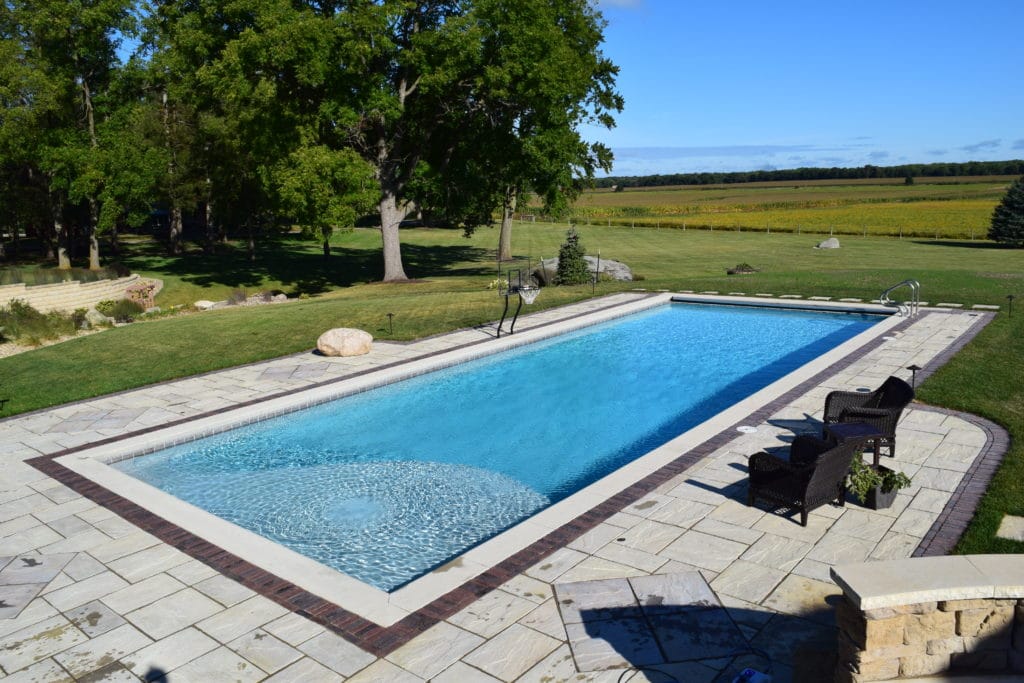There’s no doubt that splashing around in a pool on a summer’s day is one way to live your best life! But, is a pool a pool? In Iowa, there are commonly three types of inground pool options to consider: concrete, vinyl liner, or fiberglass swimming pools. When it comes down to it though, does the body of water which you decide to float on really matter? If so, why? What are the pros and cons of the options that exist in the market today?
Does this ring a bell? We aren’t surprised because it’s a common question that we hear ALL THE TIME when someone is beginning to consider what direction to go with their pool project.
Over the 20+ years that we have been building pools, our core competency has remained in concrete pool construction, although we have installed and consulted on vinyl liner and fiberglass projects, as well. The main considerations between the three come down to cost, installation and structure, customizability and lifetime.
Here, we will break down all three.
Concrete
We may be a little biased, but when comparing concrete, to vinyl liner, to fiberglass, a concrete pool checks off all the marks to being a premium product. With that comes a premium price tag. When thinking about cost, we often tell our customers to think of concrete pools as the “Ferrari of swimming pools”.
With consideration to quality, in most cases, a concrete pool will outlive the people who built it. Concrete pools are built with walls reinforced with steel and concrete so the walls are self-supportive. Typically the only maintenance or repairs needed throughout the life of a concrete pool involve the mechanical equipment or cosmetic renovations such as re-plastering or re-tiling the pool surface to update the pool aesthetic.
When spending the money it takes to build a custom concrete pool, you should be able to have everything you want. When it comes to customization, a concrete pool provides endless possibilities. Based on your wants and needs, everything from the shape, the size, and the depth can be custom designed. With concrete pools you can add in water features such as waterfalls, sunshelves and benches. You can even custom select color combinations for the pool plaster, tile, or even the concrete decks to tie in with the property or exterior colors of the home.
Fiberglass
Fiberglass pools are considered the next most expensive of the three inground pool options.
In Iowa, we tend to see drastic climate fluctuations which can definitely affect the lifespan of a fiberglass pool. As a relatively new option to the inground pool market, it is our opinion that fiberglass pools simply have not been tested enough to know how long they can hold up within the Iowa climate conditions. Other parts of the country may say otherwise. We have a hunch, however, that they are not able to sustain as long as a concrete pool. Although a fiberglass pool may be less of an upfront investment, it seems they could get costly to maintain or replace after awhile.
When it comes to fiberglass pool installation and customization, it’s best to think of it as a cookie cutter option. Customization is possible, but not nearly to the level of a concrete pool. Typically with a fiberglass pool, a handful of shapes, sizes, and shell colors are available to select from. This is something to consider when trying to determine how well you want the pool to blend in with the natural environment and color scheme of your home.
Vinyl Liner
Vinyl liner pools are the least expensive of the three inground pool options. They are also the most popular option in the Iowa residential market from what we’ve seen. In fact, we received so many requests for vinyl liner installation that we expanded our construction department to meet demand. Now we say vinyl liners are the “least expensive” with the caveat that they are least expensive upfront. Inevitably, liners need to be replaced over time. As a result, there is recurring costs with a vinyl liner that you won’t see with concrete or fiberglass pools.
When installing a vinyl liner, the walls are not self-supportive like a concrete pool, therefore, proper soil compaction is key. In addition, there must be fill dirt behind the vinyl walls to support the structure. The pool must always have water in it too, because if the pool loses water, the walls have potential to cave in. Needless to say that could ruin the pool. On that note, vinyl liners themselves are simply a membrane and can tear. It is possible to patch a liner tear, but it may not be aesthetically pleasing. Sun and chemicals can also fade a vinyl liner. Optimistically, the average liner itself lasts 5-7 years before needing replaced. Proper installation, maintenance and care will determine how frequently that timeline truly is.
Like fiberglass pools, vinyl liners are customizable to an extent, but only to the extent of options offered. Various shapes, liner designs, and colors are all possibilities. Of course, you can get creative with concrete decking and landscaping, to add customization that the pool itself cannot offer.
Which one is for you?
So that…in a pool shell (haha! pool puns)…is the difference between the three most common types of inground swimming pools built in Iowa. There’s a little something for everyone and that’s just the way we like it.
Starting to think about summer…or better yet…that pool project you’ve been longing to start for years? Send us an email at [email protected]. We’d love to answer any more questions you might have and start working on what we can build for you.

